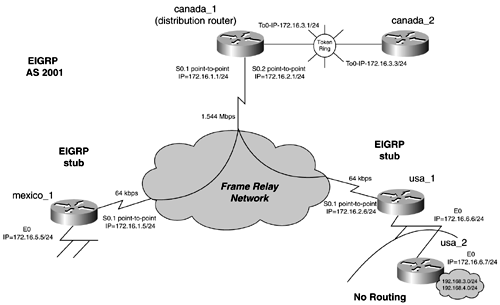Configuring OSPF
| < Free Open Study > |
EIGRP Stub RoutingIn Cisco IOS Software Release 12.0(7)T, Cisco introduced EIGRP stub routing to further control stability and reduce resource utilization. This feature was fully integrated into Release 12.0(15)S. EIGRP stub routing functions very much like that of an OSPF stub area. The stub router has one exit path from the routing domain and forwards all traffic to a central or distribution router. Another way to say this is that the stub network cannot be a transit router for EIGRP, and it can have only one EIGRP neighbor. When configuring EIGRP stub routing, only the remote or the spoke router needs to be configured as a stub. This router responds to queries for summaries, connected routes, redistributed static routes, external routes, and internal routes with the message "inaccessible." This process greatly reduces the overhead associated with responding to queries by the remote routers. The stub router also sends special peer information to its neighbor informing its neighbor that it is a stub router. To configure EIGRP stub routing, use the following router command under EIGRP: Router(config-router)# eigrp stub [ receive-only connected static summary ] The options are described as follows :
A stub router can be configured to advertise connected and static routes at the same time, which is the case in most stub domains. Figure 11-12 shows two EIGRP stub networks configured. The mexico_1 router is configured as a stub router that advertises only its local Ethernet network. The usa_1 router advertises its local Ethernet network along with two static routes to the 192.168.3.0/24 and 192.168.4.0/24 networks. The usa_2 router has a default gateway pointing to 172.16.6.6 and has no routing enabled. The distribution router is canada_1. No additional EIGRP configuration is necessary on the distribution router. Figure 11-12. EIGRP Stub Routing Example 11-29 lists the EIGRP configuration of the mexico_1 and the usa_1 routers. Example 11-29 EIGRP Stub Configuration! hostname mexico_1 ! router eigrp 2001 network 172.16.0.0 default-metric 1544 100 254 1 1500 no auto-summary eigrp stub connected Finally, by viewing the canada_1 route table, all routes are being reported by EIGRP in the correct manner. Example 11-30 lists the route table of the canada_1 router. Example 11-30 Route Table of canada_1 with Two EIGRP Stub Domains canada_1# show ip route Codes: C - connected, S - static, I - IGRP, R - RIP, M - mobile, B - BGP D - EIGRP, EX - EIGRP external, O - OSPF, IA - OSPF inter area N1 - OSPF NSSA external type 1, N2 - OSPF NSSA external type 2 E1 - OSPF external type 1, E2 - OSPF external type 2, E - EGP i - IS-IS, L1 - IS-IS level-1, L2 - IS-IS level-2, * - candidate default U - per-user static route, o - ODR Gateway of last resort is not set 172.16.0.0/24 is subnetted, 5 subnets D 172.16.5.0 [90/2195456] via 172.16.1.5, 01:03:47, Serial0.1 D 172.16.6.0 [90/2195456] via 172.16.2.6, 00:48:40, Serial0.2 C 172.16.1.0 is directly connected, Serial0.1 C 172.16.2.0 is directly connected, Serial0.2 C 172.16.3.0 is directly connected, TokenRing0 D EX 192.168.4.0/24 [170/2195456] via 172.16.2.6, 00:43:27, Serial0.2 10.0.0.0/8 is variably subnetted, 2 subnets, 2 masks D 10.1.2.0/30 [90/304128] via 172.16.3.3, 07:31:49, TokenRing0 D 10.1.1.0/24 [90/304128] via 172.16.3.3, 07:31:49, TokenRing0 182.16.0.0/24 is subnetted, 2 subnets D 182.16.4.0 [90/304128] via 172.16.3.3, 07:31:49, TokenRing0 D 182.16.3.0 [90/304128] via 172.16.3.3, 07:31:49, TokenRing0 D EX 192.168.3.0/24 [170/2195456] via 172.16.2.6, 00:43:28, Serial0.2 canada_1# To verify that the router is configured as an EIGRP stub router, use the show ip eigrp neighbor detail command. The last line of the output will show whether stub routing is enabled and what the stub router can advertise. This output can be viewed in Example 11-41. The show eigrp packet stub command shows debug information about the stub status of the peer routers. |
| < Free Open Study > |
EAN: 2147483647
Pages: 283
